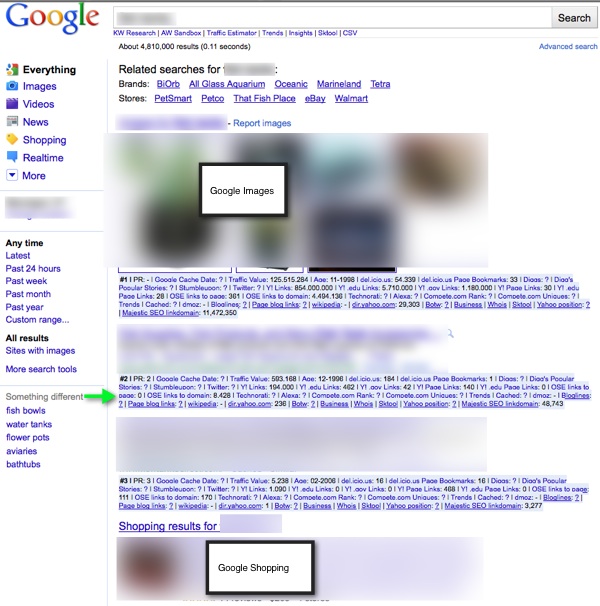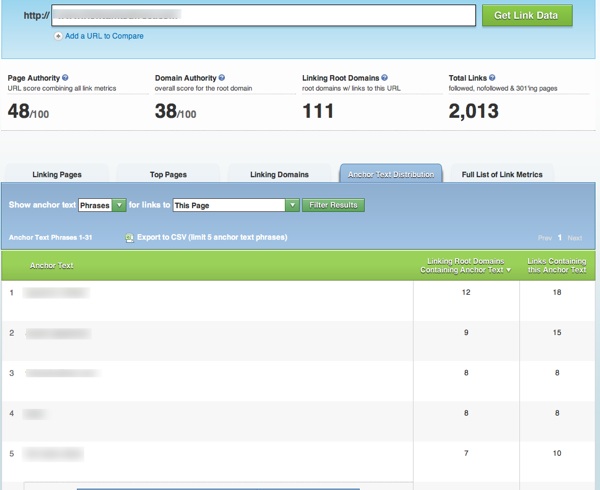
Posted by willcritchlow
Over the next two weeks, I’m speaking at our Advanced Link Building conference in London (18th March) and New Orleans (25th March). We are down to the last few tickets for London but there is definitely still time to book tickets for New Orleans to see this amazing line up of speakers give it up. Remember that the free trial of SEOmoz PRO means that anyone can get tickets at the discounted price of $450 (down from $600).
The topic of my presentation is scaling white hat link building.
Although SEO is one of the “free” organic marketing channels, there is no doubt that competing with the biggest brands and most aggressive web marketers is not going to be free. In fact, it could be very expensive. I won’t be sharing ways to compete with the link buyers for free with no effort, but I will be sharing real strategies brands can use when they need to step it up a gear.
Today, I wanted to write about just one element of that presentation – partly to get my thoughts in order and partly to give something away to those who can’t make it in person. The bit I have chosen is an element that has been front of my mind at Distilled for a few months now – namely scalable content.

Scalable Content
If you haven’t already read the article Wired wrote about how Demand Media operates, I can’t recommend it highly enough. Even (or perhaps especially) in light of the recent Panda / Farmer update, I think it is important to think about how you would operate if you had to do it at this scale. Even more importantly, we should all look for the lessons we can learn that will make us better.

It strikes me that there are three particularly notable aspects to the Demand process:
1. Cost
“it’s fast, cheap, and good enough(*)”
(*) Obviously, this was written before the recent Google update and was, in any case, debatable, but nonetheless, it’s clear that there are major efficiencies to be had versus the process many of us use to create content
2. Scale
“Demand will be publishing 1 million items a month, the equivalent of four English-language Wikipedias a year.”
This is interesting regardless of what you think of the quality – it’s an amazing feat and there has to be something we can learn.
3. Quality(**)
(**) for some definition of “quality”
“every algorithm-generated piece of content produced 4.9 times the revenue of the human-created ideas”
There are clearly things computers are better at than humans. One of these is mining data for patterns to see what is successful.
One of my long-running wishlist ideas is a database of great headlines – based largely on offline media categorised by their likely effectiveness. Have you ever stopped to look at the headlines on consumer magazines and compared them month over month? I feel like I should give credit for that tip – but I can’t remember where it came from – perhaps Todd’s suggestion of a headline “swipe file”. Anyway, in a similar fashion to I’d love to be able to run something like:
select * from headlines where subject like "<topic>" and keyword like "<keyword>" and successful = 1
What’s this all got to do with link building?
While “links” are pretty easy to understand, “link building” is a phrase that actually covers many dozens of potential approaches and tactics. Across all these myriad different kinds of link building, the consistent themes are:
-
[WHAT] – a piece of content receives the link
-
[WHO] – someone places the link
-
[WHERE] – a piece of content contains the link
I would argue that there is not a single white hat link building technique that would not benefit from better content either in the what or the where. And for every link that is not the result of a very close relationship or exceptional piece of evergreen content / functionality, scaling will come from either creating greater volume of content on your own site or creating greater volumes of content to appear elsewhere.
I will leave it as an exercise for the interested reader to think about the various forms of “good” links that you could get more of if only you had a stream of great content.
Great content?
Well, while we are trying to learn from Demand Media, I’m not necessarily talking about emulating them. Especially if we are creating content for link building, the bar is a little higher.
My research shows that on average, a piece of Demand Media content gathers links at less than 10% of the rate of a piece of BBC or New York Times content. I’ll be sharing more of this research at the conference.

This story, for example has links from almost 4,000 unique domains…
So, we know we need to raise the bar, but the question is “how”?
I think this looks something like:
- Using only great writers
- Applying quality control at multiple stages of the process
- Automating what you can
- Filling the hopper intelligently based on what the linkerati really wants
- Not being afraid to scale
I have been thinking about this not only to write my presentation, but also because we have been building out processes, systems and a network of writers to be able to scale this kind of service. The following breakdown is my opinion on some of the detail areas involved:
Using only great writers
We have some great writers on our team (in my opinion) but when we start talking about increasing scale, it doesn’t always come with full time employees. My mantra for this is that we want to be a model agency for writers when we are doing this kind of work. Whereas many of the writing services I’ve come across seem to be more like marketplaces, we want to behave more like a model agency. Model agencies don’t just take on anyone – there is a selection process to make sure they have the looks, attitude and skills to succeed. We don’t just want people who can string a sentence together; we want people who can make words sing.
This does affect the cost part of the equation. You simply can’t achieve this at the rates Demand are paying. By paying many times as much (as much as freelance journalist rates in many cases) we can create the selectivity and environment we are seeking. (Incidentally, if you think that sounds like you, of course we’d love to hear from you).
Quality control
A benefit of the “model agency” approach is that you can apply much of the quality control early in the process to the writer instead of the writing. Once you are confident in the skills of the writer, the quality control can become much more light touch. As high-profile journalists have proven, however, you can never give up quality control entirely. We think about three kinds of quality control
- Automated (see below)
- “Second opinion” from another writer
- Editorial review from dedicated editor or consultant (or occasionally, client)
Automation
Much of the automation we have layered onto this process is driven from third party APIs that make it easy to do relatively complex things. We already have a workflow, plagiarism checking and a degree of automation in Google Doc creation. We are planning:
- The ability of qualified writers to select jobs they want
- Google Doc sharing based off the workflow / approval process
And future automation might include:
- Additional quality checks (spelling, reading level, etc.)
- Headline suggestion / refinement tools for consultants
- Resource suggestion for writers (useful links, a la Zemanta, images, videos etc.)
- Better notification and alerting around the process and deadlines
- Additional services such as transcription
Filling the hopper
At the moment, this is probably the least-thought-out part of our system. In contrast to the apparently almost-fully-automated Demand system, we are still at the stage of having our consultants (in conjunction with clients and writers) suggest and decide upon the specific content to be written.
I’d love to hear some creative ideas (and any tools that already exist) that could help speed us up or make us better here.
Scaling
As I started thinking about how you scale content, one of my first thoughts was to emulate the industries that have been scaling content for decades. News organisations have been refining the systems and processes needed to:
- gather ideas from a diverse set of sources
- write copy using both staff writers and freelancers
- apply quality control
- write compelling headlines
Particular lessons that I think we can learn from the masters include the following (my wife is a journalist and these are some of the things I’ve been most impressed by through her team):
- It turns out that the people who are good at quality control are often good at writing headlines (they’re called copy editors or sub editors)
- A small core team can manage a large volume of high quality output with a team of trusted freelance writers
- The person writing the copy isn’t necessarily the same person that decides the topic or the same person who writes the headline (and nor are these two necessarily the same person either)
However, I do think there are some things that I think many journalists could learn from the geeks among us – mainly web apps:
-
Version control – one of the first things I built into our spec was the ability to see who had made which change to a draft and when. I was amazed to learn that this simple feature (present in such ubiquitous software as Word and Google Docs) is not standard on news desks. I’m sure some have it, but it’s common for plain text or untracked Word to be received from external writers and passed through the system until it hits the flatplan. At this point, many organisations take everything offline to work only in hardcopy.
-
Project management apps – for similar reasons, there is often no end-to-end system managing the process of where everything is in the system. One of the things I wanted our system to have was a simple way for all the interested parties to see the status of everything – to my mind, this includes:
- Editor / owners being able to see all outstanding jobs
- Writers having their own dashboard to see what they are working on
- Consultants having project dashboards
- Finance having reports on spend across the board and on specific projects
Do you have all this stuff?
The short answer is “no”. My role is largely R&D these days and a lot of what I described above is still at either the R or D stages in Distilled, but it’s pretty much all in the pipeline and the early signs are that it is beneficial to our projects and our consultants. We’re putting $10k / month+ through the system so far and it’s holding up pretty well with relatively minimal management. Next step is to pare down the internal management requirement still further, but I’m pleased with how it’s going so far.
If you like exploring this kind of idea, there is more of this as well as plenty of tips and tricks to come at the link building conferences over the next couple of weeks. As I said above, London is pretty much sold out (so grab one of the last few tickets if you’d been planning to come) but there are some tickets remaining for New Orleans. We’re going to have a great time and I hope that if you can make it to the fun-filled South, we’ll see you there.

Do you like this post? Yes No
 Continue reading →
Continue reading →
 We just published a major update to the ManageWP service. Biggest news are new interface and enhanced security (no more blog passwords required, SSL signed communication). Read the whole news post on ManageWP blog. Related Articles:ManageWP gets more powerful ManageWP.com has been Launched! SEO Smart Links Major Update Coming WordPress Security How To Why you […] Continue reading →
We just published a major update to the ManageWP service. Biggest news are new interface and enhanced security (no more blog passwords required, SSL signed communication). Read the whole news post on ManageWP blog. Related Articles:ManageWP gets more powerful ManageWP.com has been Launched! SEO Smart Links Major Update Coming WordPress Security How To Why you […] Continue reading → 








